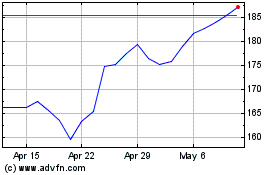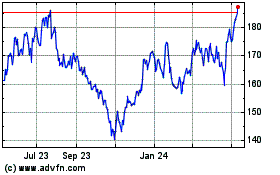SAN FRANCISCO (MarketWatch)--Seven months after taking the helm
at Advanced Micro Devices Inc. (AMD), Chief Executive Rory Read is
leading the chip giant through a period of optimism even as
analysts point to challenges in a changing market.
The upbeat views were reinforced over the past two weeks with
two AMD initiatives, including an agreement to buy the microserver
company SeaMicro.
The positive vibes are also evident on Wall Street where AMD's
stock has risen more than 40% since the beginning of the year. The
stock has outpaced rival Intel Corp. (INTC), which has risen about
12%, and the Philadelphia Semiconductor Index (SOX) which is up
16%.
Read, who previously served as chief operating officer at
Lenovo, was named CEO in August, ending a long period of
uncertainty at AMD.
At first, Read's effort to paint a generally rosy picture of AMD
was met by a fair degree of skepticism among analysts who were
still worried about the company's position in a shifting
landscape.
Bernstein Research analyst Stacy Rasgon observed how Read "tends
to talk a lot and not say much." Analyst Cody Acree of Williams
Financial Group cited the boyish-looking executive's penchant for
speaking "in broad strokes."
"It was initially a bit of a concern," he said.
But "right now, we see action that provides details to some of
the high level discussions," Acree added.
Rasgon echoed that view, saying, "It's been a long time since
they had someone in the driver's seat who's capable of actually
selling the AMD story."
In fact, Read took over at a time when the direction of the AMD
story wasn't that clear. The chip company is wrestling with a more
aggressive longtime rival Intel in the personal-computer
market.
Meanwhile, there are concerns about the future of the PC market
itself as the industry struggles with the rise of more popular
mobile devices led by the smartphone and the tablet. Analysts and
tech executives have begun referring to the post-PC era.
AMD has bet on a new PC chip family, dubbed Fusion, which
combines the capabilities of core computing chips and graphics
processors.
But that push suffered a setback last year because of capacity
constraints at GlobalFoundries, the company spun off from the
chipmaker's manufacturing operations. Essentially, GlobalFoundries
could not produce Fusion in the volumes that AMD needed to meet
demand mainly for notebooks and desktops.
AMD has fixed that problem. This week, the company announced a
new wafer supply agreement that some analysts say could potentially
improve the chipmaker's profitability.
What's gotten more analysts excited is AMD's newly unveiled plan
to buy SeaMicro, a small company with a highly regarded technology
that allows servers to operate more efficiently while consuming
less power.
The move is seen strengthening AMD's position in the server-chip
market at a time when companies are embracing cloud computing, in
which businesses access computing power through a network, instead
of setting up their own data centers.
"It's a huge deal for AMD," Evercore analyst Patrick Wang said.
"The SeaMicro deal is very meaningful and significant, reflecting
AMD's new foundation for its server business."
Longbow Research analyst JoAnne Feeney said in a note that the
SeaMicro acquisition "has the potential to place AMD at the center
of the fastest growing segment of the server market."
Acree argued that it also highlights a change in AMD's approach.
The company historically has played second fiddle to Intel in the
PC and server markets.
"AMD has historically been a fast follower in the microprocessor
market," Acree said. "Rory has come in and in just a few months has
really instilled the new mind set for AMD, to take the leadership
position."
However, Wang cautions that AMD still faces enormous challenges,
given the changes in the market, including the rise of tablets and
new form factors, such as the Intel's Ultrabook concept for
high-performance, low-notebooks.
Today, AMD must compete not only with Intel, but also with a
broader range of players, including Qualcomm Inc. (QCOM), Apple
Inc. (AAPL) and Texas Instruments Inc. (TXN), he said.
"They're competing with a very vibrant and healthy landscape of
companies out there," he said. "It's a very crowded and challenging
market."
But he and other analysts also agree that Read has brought a new
excitement to AMD.
"I think what AMD is doing is actually very exciting," Wang
said.
Rasgon cited Read's own enthusiasm as AMD's new boss. "He's
obviously excited to be there," he said. "When he says he wants to
win, I think he's serious."
-By Benjamin Pimentel, MarketWatch; 415-439-6400;
AskNewswires@dowjones.com
Texas Instruments (NASDAQ:TXN)
Historical Stock Chart
From Jun 2024 to Jul 2024

Texas Instruments (NASDAQ:TXN)
Historical Stock Chart
From Jul 2023 to Jul 2024
